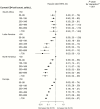Comparison of Kaposi Sarcoma Risk in Human Immunodeficiency Virus-Positive Adults Across 5 Continents: A Multiregional Multicohort Study
- PMID: 28531260
- PMCID: PMC5850623
- DOI: 10.1093/cid/cix480
Comparison of Kaposi Sarcoma Risk in Human Immunodeficiency Virus-Positive Adults Across 5 Continents: A Multiregional Multicohort Study
Abstract
Background: We compared Kaposi sarcoma (KS) risk in adults who started antiretroviral therapy (ART) across the Asia-Pacific, South Africa, Europe, Latin, and North America.
Methods: We included cohort data of human immunodeficiency virus (HIV)-positive adults who started ART after 1995 within the framework of 2 large collaborations of observational HIV cohorts. We present incidence rates and adjusted hazard ratios (aHRs).
Results: We included 208140 patients from 57 countries. Over a period of 1066572 person-years, 2046 KS cases were diagnosed. KS incidence rates per 100000 person-years were 52 in the Asia-Pacific and ranged between 180 and 280 in the other regions. KS risk was 5 times higher in South African women (aHR, 4.56; 95% confidence intervals [CI], 2.73-7.62) than in their European counterparts, and 2 times higher in South African men (2.21; 1.34-3.63). In Europe, Latin, and North America KS risk was 6 times higher in men who have sex with men (aHR, 5.95; 95% CI, 5.09-6.96) than in women. Comparing patients with current CD4 cell counts ≥700 cells/µL with those whose counts were <50 cells/µL, the KS risk was halved in South Africa (aHR, 0.53; 95% CI, .17-1.63) but reduced by ≥95% in other regions.
Conclusions: Despite important ART-related declines in KS incidence, men and women in South Africa and men who have sex with men remain at increased KS risk, likely due to high human herpesvirus 8 coinfection rates. Early ART initiation and maintenance of high CD4 cell counts are essential to further reducing KS incidence worldwide, but additional measures might be needed, especially in Southern Africa.
Keywords: HIV; Kaposi sarcoma; antiretroviral therapy; cohort study.
© The Author 2017. Published by Oxford University Press for the Infectious Diseases Society of America. All rights reserved. For permissions, e-mail: journals.permissions@oup.com
Figures



References
-
- Cancer Project Working Group for the Collaboration of Observational HIV Epidemiological Research Europe (COHERE) study in EuroCoord. Changing incidence and risk factors for Kaposi sarcoma by time since starting antiretroviral therapy: collaborative analysis of 21 European cohort studies. Clin Infect Dis 2016; 63:1373–9. - PMC - PubMed
MeSH terms
Substances
Grants and funding
LinkOut - more resources
Full Text Sources
Other Literature Sources
Medical
Research Materials

